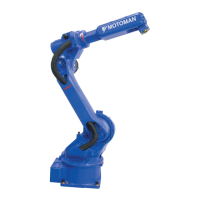4-1
168542-1CD
168542-1CD
MLX200 Software and
Operations
4 MLX200 Programming Guide
4.1 Developing a Simple Application
4 MLX200 Programming Guide
The previous sections have introduced the MLX200 data structures,
instructions, and basic HMI operation. This section will demonstrate how
to use these tools to teach positions and write MLX200 applications. The
method to do this is slightly different than on traditional Robot Control
Modules as the program itself is not developed from the teach pendant.
Instead, the MLX-HMI is used to jog the robot and teach positions, and
then these positions are accessed through a ladder program that is
developed using the MLX200 instructions in RSLogix 5000. After
describing a simple process for teaching and executing motions, the next
section will describe how to incorporate Blend Factors into your program
to reduce cycle times. Finally, some of the common best practices and
potential pitfalls from programming MLX200 are discussed.
4.1 Developing a Simple Application
This section will describe how to teach points with the MLX-HMI and then
access these points from a ladder program to perform simple point to point
motions.
4.1.1 Teaching Points with MLX-MHI
Section 3.4.1 “Setting Up the HMI” on page 3-22 introduced the
Application data structure. This structure contains an array of type
MLxAppDataJob that each contains an array of type
MLxAppDataTeachPoint. Each Teach Point contains the following
information:
• TeachPointName - optional user-description of the Teach Point
• TCPPosition - X, Y, Z, Rx, Ry, Rz position data as well as closure
information
• AxisPosition - axis position data
• UserFrameNumber - The active User Frame when the point is taught
(if not -1, the position will be converted to active user frame - see
Section xxx)
• ToolNumber - The active Tool Number when the position was taught
(used for information only)
All MLX200 application code should be placed inside the MLX_Task.
Failure to do so could lead to unexpected behavior such as skipped
motions or motions being out or order after a Hold/Restart scenario.
See Section 3.3.1 “Task Scheduling” on page 3-9.

